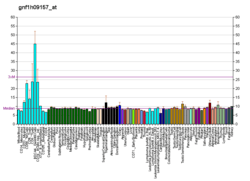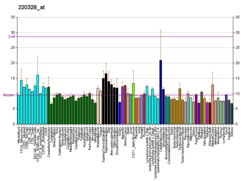References
- 1 2 3 GRCh38: Ensembl release 89: ENSG00000173889 - Ensembl, May 2017
- 1 2 3 GRCm38: Ensembl release 89: ENSMUSG00000037652 - Ensembl, May 2017
- ↑ "Human PubMed Reference:".
- ↑ "Mouse PubMed Reference:".
- ↑ Levine SS, Weiss A, Erdjument-Bromage H, Shao Z, Tempst P, Kingston RE (Aug 2002). "The core of the polycomb repressive complex is compositionally and functionally conserved in flies and humans". Mol Cell Biol. 22 (17): 6070–6078. doi:10.1128/MCB.22.17.6070-6078.2002. PMC 134016. PMID 12167701.
- ↑ Tonkin E, Hagan DM, Li W, Strachan T (Oct 2002). "Identification and characterisation of novel mammalian homologues of Drosophila polyhomeoticpermits new insights into relationships between members of the polyhomeotic family". Hum Genet. 111 (4–5): 435–442. doi:10.1007/s00439-002-0814-3. PMID 12384788.
- ↑ "Entrez Gene: PHC3 polyhomeotic homolog 3 (Drosophila)".
Further reading
- Strausberg RL, Feingold EA, Grouse LH, et al. (2003). "Generation and initial analysis of more than 15,000 full-length human and mouse cDNA sequences". Proc. Natl. Acad. Sci. U.S.A. 99 (26): 16899–16903. doi:10.1073/pnas.242603899. PMC 139241. PMID 12477932.
- Ota T, Suzuki Y, Nishikawa T, et al. (2004). "Complete sequencing and characterization of 21,243 full-length human cDNAs". Nat. Genet. 36 (1): 40–45. doi:10.1038/ng1285. PMID 14702039.
- Beausoleil SA, Jedrychowski M, Schwartz D, et al. (2004). "Large-scale characterization of HeLa cell nuclear phosphoproteins". Proc. Natl. Acad. Sci. U.S.A. 101 (33): 12130–12135. doi:10.1073/pnas.0404720101. PMC 514446. PMID 15302935.
- Suzuki Y, Yamashita R, Shirota M, et al. (2004). "Sequence comparison of human and mouse genes reveals a homologous block structure in the promoter regions". Genome Res. 14 (9): 1711–1718. doi:10.1101/gr.2435604. PMC 515316. PMID 15342556.
- Gerhard DS, Wagner L, Feingold EA, et al. (2004). "The status, quality, and expansion of the NIH full-length cDNA project: the Mammalian Gene Collection (MGC)". Genome Res. 14 (10B): 2121–2127. doi:10.1101/gr.2596504. PMC 528928. PMID 15489334.
- Nousiainen M, Silljé HH, Sauer G, et al. (2006). "Phosphoproteome analysis of the human mitotic spindle". Proc. Natl. Acad. Sci. U.S.A. 103 (14): 5391–5396. doi:10.1073/pnas.0507066103. PMC 1459365. PMID 16565220.
- Deshpande AM, Akunowicz JD, Reveles XT, et al. (2007). "PHC3, a component of the hPRC-H complex, associates with E2F6 during G0 and is lost in osteosarcoma tumors". Oncogene. 26 (12): 1714–1722. doi:10.1038/sj.onc.1209988. PMC 2691996. PMID 17001316.
- Olsen JV, Blagoev B, Gnad F, et al. (2006). "Global, in vivo, and site-specific phosphorylation dynamics in signaling networks". Cell. 127 (3): 635–648. doi:10.1016/j.cell.2006.09.026. PMID 17081983.





